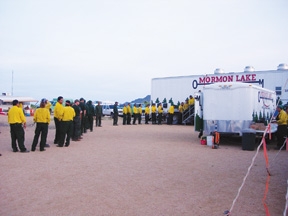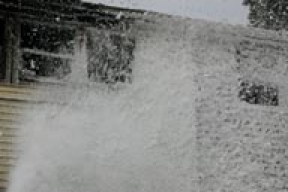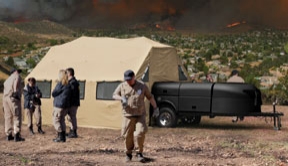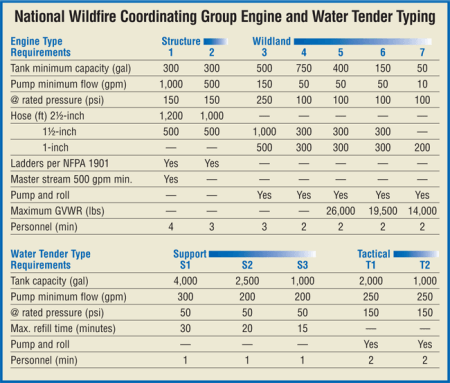 |
| Rosenbauer built this Timberwolf urban interface pumper for the Galax (VA) Fire Department. (Photo courtesy of Rosenbauer.) |
 |
| HME Ahrens-Fox has supplied a number of Type 3 wildland engines to California’s Cal Fire agency. (Photos courtesy of HME Ahrens-Fox.) |
 |
| HME Ahrens-Fox makes Type 6 attack trucks on Ford-550 chassis, allowing them to carry 300 gallons of water, 17 gallons of foam, and a 50-gpm diesel pump. |
 |
| KME Fire Apparatus builds the Ridgerunner interface pumper carrying a Hale 1,500-gpm pump, an 800-gallon water tank, a 20-gallon foam tank, and a full complement of ladders. (Photos courtesy of KME Fire Apparatus.) |
 |
| KME Fire Apparatus, in addition to its Ridgerunner, builds Type 3 apparatus, typically with a 1,000-gpm pump and 500-gallon water tank. |
 |
| BFX Fire Apparatus builds Type 6 engines for the Bureau of Land Management, the U.S. Forest Service, and municipal fire departments interested in wildland-urban interface apparatus. (Photos courtesy of BFX Fire Apparatus.) |
 |
| A typical U.S. Forest Service Type 6 engine. |
It’s the 2011 wildland fire season, and already fire departments across the country have had their hands full dealing with fires that have burned hundreds to thousands of wildland acres as well as threatened homes and businesses.
But, there is a variety of apparatus available to counter such threats, typically classified as Type 1 through Type 7 structure and wildland firefighting apparatus (see sidebar), as well as urban interface vehicles offered by manufacturers to handle fire situations where wildlands meet built-up areas.
Donley Frederickson, national sales manager for Rosenbauer, says his company produces the Timberwolf, a vehicle designed specifically for wildland and urban interface fire situations. The Timberwolf offers standard and high-pressure rear-mount pumps ranging from 500 to 1,000 gpm and uses water tanks from 500 to 750 gallons.
“We can put the Timberwolf on any chassis, but it’s most often built on an International all-wheel-drive chassis that we tilt test to 30 degrees,” Frederickson says.
He notes that the Timberwolf, which has been in production for 10 years, is typically constructed with three full-size compartments that use roll-up doors on each side of the apparatus and that the rear-mount pump is built in an open-type format to allow access to the valves and piping for maintenance and repair.
“The Timberwolf has pump-and-roll capability when operating the pump in either volume or pressure,” Frederickson points out. “The high-pressure side of the pump can run a reel of 150 feet of hose under the driver’s door at up to 100 gpm or a deluge gun on the front bumper, controlled by a joystick in the cab, at 100 gpm.”
Frederickson says Rosenbauer sells the majority of Timberwolf vehicles in the Mountain and Western states, although many have gone to Eastern locations from Massachusetts to Florida.
Ken Lenz, president of HME Ahrens-Fox, says his company has been working in the wildland apparatus field since 1999 when California’s Operation of Emergency Services (OES) and Cal Fire purchased HME’s Short Front Overhang (SFO) chassis specifically for urban interface use.
Lenz says there are more than 100 SFO vehicles in operation now in California and that HME was contracted by the state’s Emergency Management Agency (EMA) for another 28 urban interface vehicles.
“The EMA unit is an urban interface vehicle with a cab-over-four-door chassis,” Lenz points out. “The OES engine is a Model 18 Type 1 unit, while the Cal Fire vehicle is a Model 34 Type 3 built on an International 7400 all-wheel-drive four-door chassis.”
Lenz notes that HME is the only contracted manufacturer building the Model 34c units with ladders, suction, and long-handled tools mounted lower on the rig so they are easier to reach than on Model 34 units. The Model 34c is equipped with a two-stage 500-gpm midship pump, as well as a 180-gpm diesel-powered auxiliary pump with cab-mounted controls that supplies two front jump lines, a booster reel, and preconnected discharges for pump-and-roll operations. It has a 500-gallon slip-in water tank and a 20-gallon foam tank.
HME also makes wildland Type 6 attack trucks on Ford-550 chassis, running 50-gpm diesel pumps and carrying 300 gallons of water and 17 gallons of foam. The vehicles are made with stainless steel bodies to help weather the abusive environment in which such vehicles operate.
“We install large hitch plates on the front and rear of our vehicles,” Lenz notes, “so they can be cabled out of being stuck by bulldozers when necessary.”
Doug Kelley, wildland product manager at KME Fire Apparatus, says his firm’s Ridgerunner interface pumper is designed as a dual-purpose unit between a standard pumper and a wildland Type 3 unit.
“It meets NFPA 1901 for a pumper and NFPA 1906 for a Type 1 with Type 3 performance,” Kelley says. “This is a four-wheel-drive unit, and we can mount it on any chassis, but the most common is on a Navistar 4 x 4 chassis.”
The Ridgerunner carries a Hale interface pumping system of 1,500 gpm, an 800-gallon water tank, a 20-gallon foam tank, and a full complement of ladders.
“It has a high angle of departure for good ground clearance and is tested to 30 degrees of stability both left and right,” Kelley notes. He adds that the Ridgerunner can do 100 gpm at 150 psi in pump-and-roll at idle. “That’s more than enough pressure for both the front turret and the hose reel,” he says.
KME also makes a Ridgerunner version that sports a rear-mount Darley 1,250-gpm pump with a 60-gpm pump-and-roll capability and a 750-gallon water tank on a four-wheel-drive chassis.
In addition, KME builds a traditional Type 3 wildland pumper with a 175-inch wheelbase, up to a 1,000-gpm pump, and a 500-gallon water tank. Kelley notes a separate engine-driven pump on the Type 3 units gives them pump-and-roll capability.
“Fire departments tell us they want pump-and-roll capability with really good pressure that can put an effective stream of water on a fire,” Kelley says. “And, for interface pumpers, they’re asking us to shorten the package as much as we can because they think that trucks are getting too big. So, we make sure there’s no wasted space on our trucks, building every compartment as wide as possible and even putting storage over the wheel wells.”
Kelley notes that wildland pumpers have to stand up to the rigors of off-road work, so bodies must be strong and robust.
“For most fire departments, water flow is the name of the game, but in wildland firefighting, when you’re dealing with terrain and long hoselays, pressure is as important as flow,” Kelley observes.
He says KME has been successful on a number of bids in supplying wildland apparatus to the Federal Bureau of Land Management (BLM) and the U.S. Forest Service. As for rural and suburban municipal fire departments, Kelley says he “sees more Type 6 units going out our door rather than Type 3 vehicles, because the Type 6 will see more use as a general-purpose truck.”
Will Seeley, a captain at Golder Ranch Fire District in Oro Valley, Arizona, says wildland and urban interface vehicles need to be smaller and more maneuverable than traditional pumpers because they often have to get into much tighter areas.
Golder Ranch has a Type 3 unit that seats four on a four-wheel-drive Freightliner chassis, with a 350-gpm pump and 500-gallon water tank. It also runs two Type 6 trucks on Ford-350 four-wheel-drive chassis with Hale 250-gpm skid-unit pumps and 300-gallon water tanks.
“As we’ve evolved as a wildland team, we’ve worked with apparatus designers and mechanics to maximize the area on our vehicles for tools and equipment storage,” Seeley says. “Besides the shelving units inside the compartments, we have racks on top of the skid units for tents, water, and personal equipment.”
The Golder Ranch wildland team, consisting of an engine boss and two wildland firefighters, has fought wildland fires in Arizona, California, Oregon, Texas, and Montana.
Dave Haston, mechanical engineer with the U.S. Forest Service, says the Forest Service and the BLM have very detailed specifications on what they want in a wildland firefighting apparatus.
“Besides requiring compliance with NFPA 1906, we also look to the typing requirements set forth for engines and water tenders (tankers) by the National Wildfire Coordinating Group (NWCG),” Haston says. “If you want to participate on federal incidents, your apparatus has to meet the NWCG requirements for engines and tenders because they require some things that aren’t required in NFPA 1906.”
Besides the specific requirements for engines and water tenders, all types working federal incidents have to meet federal, state, and agency motor vehicle safety standards, including gross vehicle weight ratings when fully loaded, Haston notes. Type 3 engines and tactical water tenders have to be equipped with a foam proportioner system, and all water tenders and Type 3 through Type 6 engines have to be able to prime and pump water from a 10-foot lift.
Common additional needs that are requested as necessary, Haston says, include all-wheel drive and four-wheel drive, high-pressure pumps (250 psi at one half flow of the type of foam proportioner), and a CAFS of 40 cfm minimum.
“In a true wildland scenario, it’s important to have a pump operate at high pressure rather than high volume because we have long hoselays, often several thousand feet long, typically of 1½-inch- diameter hose,” Haston says. “Plus there’s the issue of elevation gain over the terrain we’re operating on. In a Type 3 unit, we require a continuous operation at 400 psi, typically flowing 50 to 60 gpm.”
He adds, “We carry a finite amount of water when fighting wildland fires, so we have to manage our water use carefully.”
On an urban interface vehicle, where the rig might have to do structural firefighting as well, Haston notes a Type 3 could operate at 250 gpm at 150 psi.
Haston says wildland apparatus pump from draft quite a bit, both from water sources and portable tanks.
“Portable tanks give us a more continuous supply of water from which to pump because they are being supplied by water tenders and have a pumper assigned to the tank to pump to the lines,” he says. “But you can only pump so many gpm through a 1½-inch hose because of friction loss and elevation gain.”
Haston notes that on Forest Service Type 3 engines, 75 percent of those in use are two-wheel-drive units that use a locking rear differential.
“They do extremely well off-road,” he says. “We see the four-wheel-drive apparatus getting stuck more because the operators feel they can go in deeper. The joke among us is that the difference between the two (two-wheel drive vs. four-wheel drive) is 50 feet.”
Perry Shatley is sales manager of BFX Fire Apparatus, which builds Type 6 engines for the BLM and Forest Service. A typical BFX Type 6 engine carries up to 350 gallons of water and 20 gallons of foam and has more than 75 cubic feet of side compartment storage.
“We use a fiber composite material in our bodies and shelving that provides structural strength and durability,” Shatley says, “and flexibility where the material flexes with the vehicle’s movement and comes back to its original configuration.”
BFX, which has been building fire apparatus since the early 1990s, offers pump packages that are customer-driven, Shatley notes.
“If there’s a small application for an auxiliary-driven pump out there, we’ve probably used it,” he says. “Darley is one of the preferred pumps now, but we’ve also used Waterous and Hale pumps. We install a lot of the Darley 1.5 auxiliary pump systems, plumbing them into the chassis so when you fill the chassis with diesel fuel it fills the auxiliary tank, too.”
Shatley says he’s seen some fire departments moving toward gasoline-driven pumps because diesel fuel is getting so expensive.
“They’re using 18- to 30-hp gas motors with pumps like the BB4 pump,” he notes. “However, for the BLM and Forest Service, all we use is diesel-powered pumps.”
Although the BLM and Forest Service are BFX’s main customers, the company has sold vehicles to a variety of fire departments.
“They’ve seen our body system allows them to carry more of a payload,” Shatley says. “The fiber composite material is about 50 percent less than steel in weight and about 30 percent less than aluminum. That allows additional equipment to be carried on the truck without increasing its size.”
ALAN M. PETRILLO is a Tucson, Arizona-based freelance writer. He served 22 years with the Verdoy (NY) Fire Department, including in the position of chief.
More Fire Apparatus Current Issue Articles
More Fire Apparatus Archives Issue Articles


